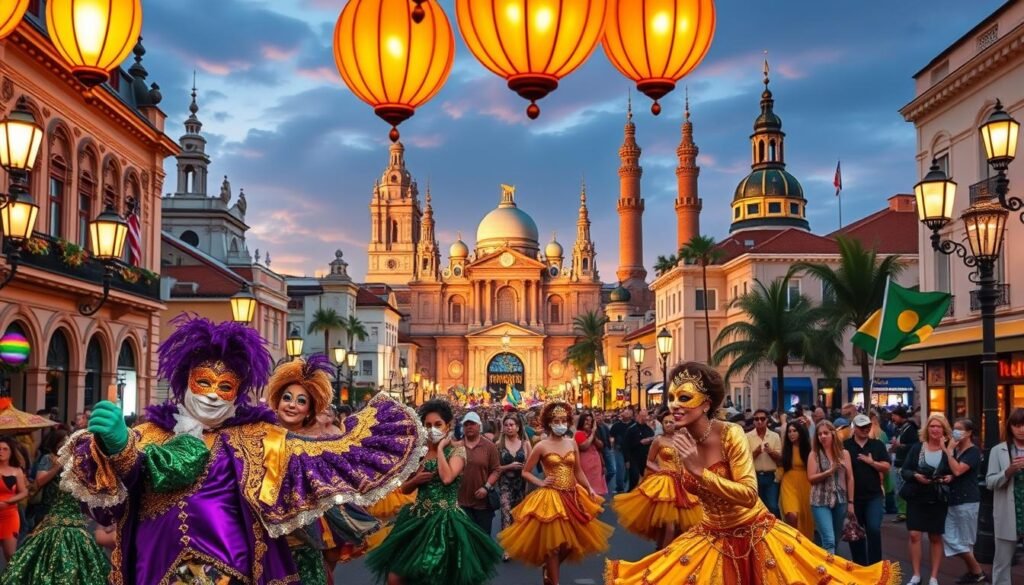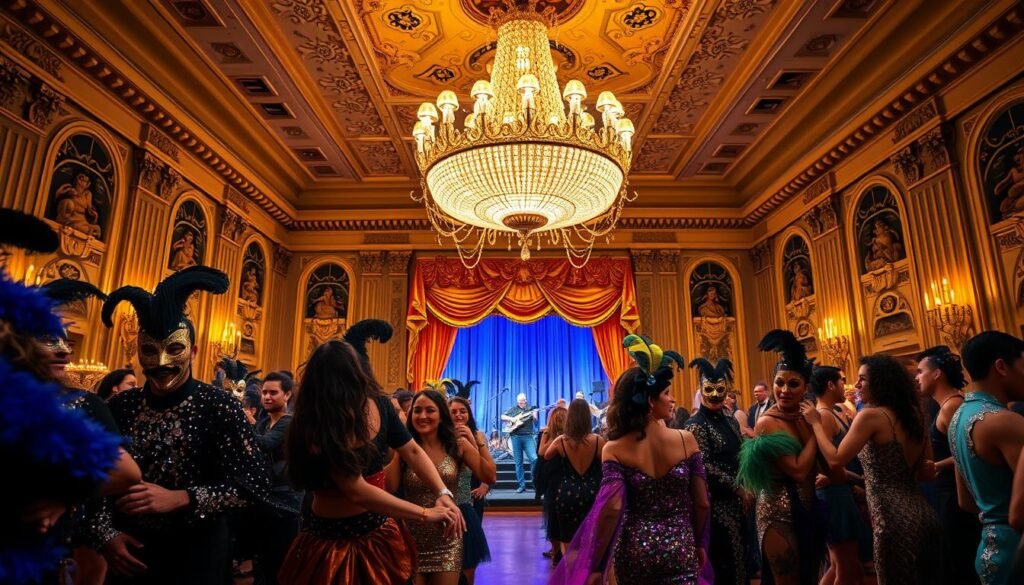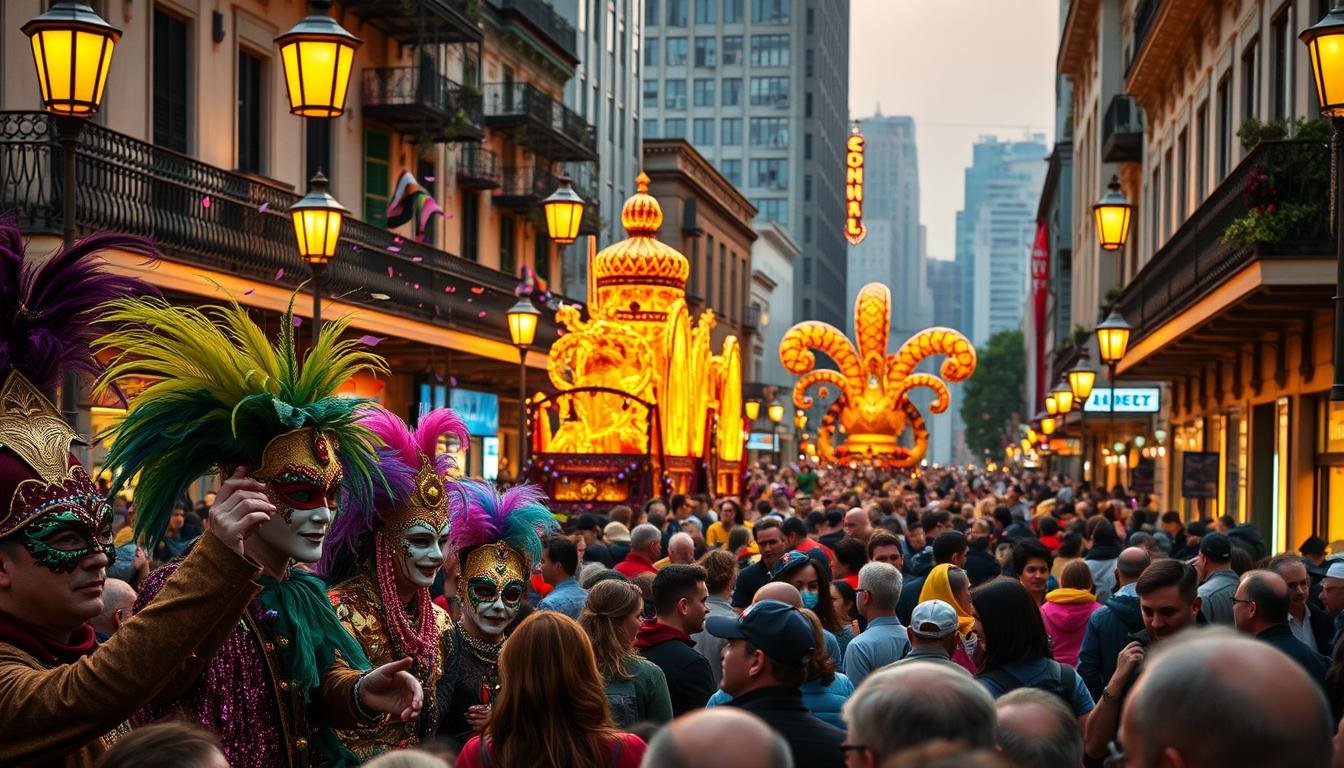I’m your local friend in New Orleans — I’ve walked parade routes, waited for throws, and tasted king cake at dawn. This guide is a friendly map: where to go, what to taste, and how to move through the season with respect and a grin when Fat Tuesday arrives.
The season here starts on Twelfth Night and runs until the day before Ash Wednesday. That stretch lets the city breathe and build momentum — neighborhood parades, krewes with long roots, and an energy that pulls people in from across the country and around the world.
Expect tips on throws like beads and doubloons, the foods that matter, practical dates for the year, and simple etiquette so you can enjoy the event without stepping on toes. I’ll point out where Mobile fits in history, mark the big dates, and show how this city’s life feels different — more of a living tradition than just a holiday.
Key Takeaways
- The season begins on Twelfth Night and ends the day before Ash Wednesday.
- New Orleans blends parades, food, and long-held krewe traditions.
- Know basics: dates, safe spots on routes, and balcony etiquette.
- Throws—beads, doubloons, Zulu coconuts—are part of the fun and have catching rules.
- This guide helps you enjoy the day and bring a bit of local life home with you.
Quick primer: What Mardi Gras means, when it happens, and why we celebrate
Think of this as a quick map—what the season stands for, how its dates move, and why that last day matters to both partygoers and parishioners.
I mark the start on Twelfth Night (Epiphany, Jan 6) when king cakes show up and small parades begin to roll. In New Orleans the season stretches from then through the day before Ash Wednesday, building toward the big finale: mardi gras.
The final day is often called Shrove Tuesday, a name from the old verb “to shrive,” meaning to confess. That explains the feasts—pancakes, eggs, butter—meant to use rich foods before Lenten fasts.
Dates shift because Easter moves. Count back forty-seven days and you’ll hit the date—so the calendar changes from year to year. For 2025, circle March 4 for mardi gras.
From Twelfth Night to Fat Tuesday: the Carnival season timeline
- Jan 6: season wakes—king cakes and small parades.
- Weeks of neighborhood events build toward the final days.
- Final four or five days: the largest parades and heaviest crowds.
Shrove Tuesday and Ash Wednesday: the transition into Lent
Shrove Tuesday is the last feast day; Ash Wednesday begins a quieter, reflective period. Old-world customs crossed the Atlantic over the centuries and took on a local flavor here in our city—part pageant, part ritual, all alive in the streets.
The epicenter: How to celebrate Mardi Gras in New Orleans
If you want the real pulse of the season, follow the floats from Uptown down St. Charles and let the city do the rest. Start Uptown—Napoleon Avenue to St. Charles—and feel how the route pulls the week into motion.
Parade basics: Krewes are the groups that build the floats, pick themes, and hand out throws. You’ll see beads, stamped doubloons, snacks, and the prized Zulu coconuts fly through the air. Catch with a smile—don’t lunge—and respect the people around you.
Don’t-miss moments: Plan around the super krewes. Endymion and Bacchus bookend the weekend, while Zulu and Rex own Fat Tuesday. Rex’s colors—purple (justice), green (faith), gold (power)—set the tone for the carnival.
Taste the season: King cake is a cinnamon ring iced in royal colors with a tiny baby inside. Find it, and you bring the next cake. Local bakeries like Manny Randazzo’s and Dong Phuong are classic stops for this seasonal food.
Year-round fun: When parades aren’t rolling, tour Mardi Gras World at Blaine Kern Studios. Stand next to the floats and you’ll see the craft behind the spectacle—an insider place for any visitor.
- Start Uptown for shade, oak-lined streets, and steady rhythm.
- Dress up—costumes welcome—and if you ride a float, Louisiana law requires a mask.
- Keep plans loose: pick a meeting spot, hydrate, and savor the music—this event moves at its own joyful pace.
Mardi Gras celebrations around the world: best places beyond the Big Easy
Travel shows how one tradition wears many faces. I’ve chased parades here and abroad, and these cities stand out when you want to celebrate mardi gras around world.

Rio de Janeiro, Brazil
Start in Rio for sheer scale—two million people in the streets and blocos that run before the Sambódromo shows. Buy big-parade tickets early and join a bloco for the real samba school energy.
Venice, Italy
Venice leans elegant: masked balls, Grand Canal boat parades, and the Flight of the Angel. Many events are ticketed—plan ahead if you want inside access to the costumes and salons.
Binche, Belgium
Binche’s Gilles toss oranges and wear centuries-old garb. UNESCO named it intangible heritage in 2003—this one feels ancient and strict in its ritual.
Basel, Switzerland
Fasnacht begins at 4 a.m. after Ash Wednesday with lanterns and sharp satire. It runs 72 hours and pulls a very different, theatrical energy into the streets.
Trinidad & Tobago
Here, J’Ouvert wakes you pre-dawn with paint, steelpan, and soca. Sign with a mas band to play the road—this is raw, rhythmic, and sticky with sunrise joy.
Sydney, Australia
Sydney’s Gay and Lesbian Mardi Gras blends pride with parade spectacle—floats, drag, and headline acts—showing how the name travels across countries and cities each year.
Practical tip: If you plan to celebrate mardi gras around world, book tickets and hotels early and respect local costume rules—do your homework and you’ll be welcomed.
America beyond NOLA: great U.S. cities to celebrate Mardi Gras
Beyond New Orleans, a handful of U.S. cities stake proud claims to long-running parade traditions. Each place has its own rhythm—some proper balls, some porch-to-porch runs.
Mobile, Alabama wears the crown for earliest organized festivities—dating to 1703. Mystic societies like the Order of Myths (1867) still march, with parades and formal balls that honor a century-deep lineage.
St. Louis, Missouri centers in Soulard. The season kicks off on Twelfth Night and builds into stacked weekends that finish on Fat Tuesday. It’s the Midwest’s big parade draw, with neighborhood pride and music.
Galveston, Texas keeps a 19th-century flair. Since 1871 the Knights of Momus and Knights of Myth have staged themed floats, masked balls, and night parades under Gulf skies.
Acadiana, Louisiana turns rural with the Courir de Mardi Gras—patchwork costumes, house-to-house stops, and a communal gumbo at the end of the run. It’s a window into older, folk-rooted traditions.
| City | Historic start | Highlight | Best time / tip |
|---|---|---|---|
| Mobile, AL | 1703 | Mystic societies & formal balls | Book tickets early for balls |
| St. Louis, MO | 19th century growth | Soulard parades, Twelfth Night kickoff | Arrive before Fat Tuesday for prime spots |
| Galveston, TX | 1871 | Themed floats & masked balls | Night parades require layered plans |
| Acadiana, LA | Folk roots (medieval France) | Courir de Mardi Gras rural run | Wear sturdy boots; expect early starts |
Pick one city and settle in—rushing between places in the middle of the season can turn fun into fatigue. Plan by days, budget for ticketed balls, and give space to locals and families. You’ll leave with new stories and new friends.
Traditions that define the season: parades, beads, masks, and costumes
Stand under a balcony and you’ll see how ritual and play mix—royal colors, flying throws, and masks that let folks become stories for a day.
Official colors: Purple, green, and gold were set by Rex in 1872. They mean justice, faith, and power. You’ll find them on banners, king cake icing, and porch railings through the season.
Beads and throws: Throws are souvenirs of the day—beads, doubloons, and small handmade items. Catch with a grin, then consider recycling. Many crews and neighbors collect used beads to reuse or donate so the holiday keeps giving.
Masks and anonymity: In Louisiana mask rules are narrow—public masking is limited, but parade time is an exception. Float riders must wear masks or face paint by law. On the street, a simple mask invites play while we still treat one another with care.
Costumes: Fairies, mythic beasts, and medieval garb have long been part of the tradition. Wear something that moves, lets you eat, and makes you grin. Today we lean toward sustainable throws and kinder practices—follow local cues and be part of the rhythm.
Krewes and balls: inside the groups that make the magic
Krewes are the engines of parade season—organized, passionate, and often delightfully secretive. They are formal groups with officers, dues, and bylaws that plan parades and private events.

What is a krewe? Membership, traditions, and parading “super krewes”
A krewe is a community within the celebration—a group that builds floats, raises funds, and schedules shows. Some are neighborhood-scale; others are super krewes with huge floats and celebrity riders.
Rex, royalty, and the King of Carnival
Rex dates to 1872 and the visit of Grand Duke Alexis. That name gave us purple, green, and gold and the yearly King of Carnival who receives a symbolic key to the city.
Invitation-only balls and the dramatic unmasking
Many balls remain private affairs—formal, theatrical, and invitation-only. At the unmasking, faces drop and the pageant becomes personal.
| Feature | What to expect | Tip |
|---|---|---|
| Membership | Dues, committees, volunteer hours | Ask about timelines before joining |
| Parades | Public face of the group; throws and floats | Respect routes and local rules |
| Balls | Invitation-only, masked unmasking | Formal dress and etiquette expected |
| Funding | Community-funded; no corporate logos in Orleans Parish | Support local efforts or donate used throws |
Parades and balls together keep a century-plus of tradition moving. I’ve watched old-line families and first-time riders build the same float—proof that this group work is how the season stays alive.
Plan your trip: dates, routes, foods, and smart tips for Fat Tuesday
Lock the date, claim a spot, and save room for king cake—those three moves make the day sing.
Key dates and how Fat Tuesday is set
Count back 47 days from Easter to find the final party. For 2025, that lands on March 4.
Use that math each year so you don’t miss parades stacked the last weekend. Remember Shrove Tuesday names the final feast day and Ash Wednesday starts the next, quieter period.
Where to stand, navigate crowds, and balcony etiquette
In New Orleans, the Uptown route—Napoleon down St. Charles toward the Quarter—gives shade and steady flow.
Pick a side of St. Charles and stick to it. Crossing mid-parade disrupts bands and people. Set a meetup spot and share it with your crew.
Balcony views are dreamy but often need wristbands or reservations. Ladders are for kids—set them back from the curb so floats and foot traffic stay safe.
Essential eats: king cake, local bites, and where to find them
Eat like a local to keep your energy. Split a king cake slice, grab a po’boy or gumbo near your spot, and stash water.
If you want a famous cake, Manny Randazzo’s draws long lines and Dong Phuong ships nationwide. Save museum and Mardi Gras World tours for the quieter days of the season.
- Quick tips: Arrive early, use rideshares to drop a few blocks out, wear comfy shoes.
- Plan for the end: After Fat Tuesday, many services pause—treat the next morning gently.
Etiquette, safety, and local rules to celebrate Mardi Gras respectfully
You’ll have more fun if you learn the local rules before you join the crowds. I say that as someone who’s stood on parade routes for years—small moves keep big smiles on the street.
Masks and parade regulations: In Louisiana, public masking is limited, but parade time is the exception. Float riders must wear masks or face paint. On the street, costumes and masks are welcome—be ready to show your face to security if asked.
Safety on the route: Don’t cross between floats. That’s dangerous and rules forbid it. Keep ladders back from the curb and give bands room to march.
Bead etiquette and community-first behavior: Catch what comes to you and don’t shove. If your arms are full, hand a throw to a child or elder. Many locals recycle beads—consider doing the same after the holiday.
- Set meeting points and keep phones charged for tight times and crowded days.
- Pack out trash, respect ticketed balconies, and avoid blocking venue entrances.
- Hydrate, use sunscreen, and pace yourself across the long period of parades.
If you see someone in trouble, flag an officer or marshal—our people look out for one another. Celebrate loudly, be mindful of others, and leave the route better than you found it.
Conclusion
After the final float, what stays isn’t just beads and music—it’s the way strangers became neighbors and a city taught you to slow down and savor the moment. a strong.
If it’s your first time, start in New Orleans and let curiosity carry you to other places around the world. Celebrate with intention: eat well, dance kindly, tip your servers, and thank the float crews who make the season happen.
Pick a corner that matters to you—the porch, the brass line, the king cake slice—and keep that memory. Mark next year on your calendar today, pack a little extra patience, and bring someone you love. When you’re ready for more, I’ll save you a spot by the oaks on St. Charles to celebrate mardi gras again.

Leave a Reply